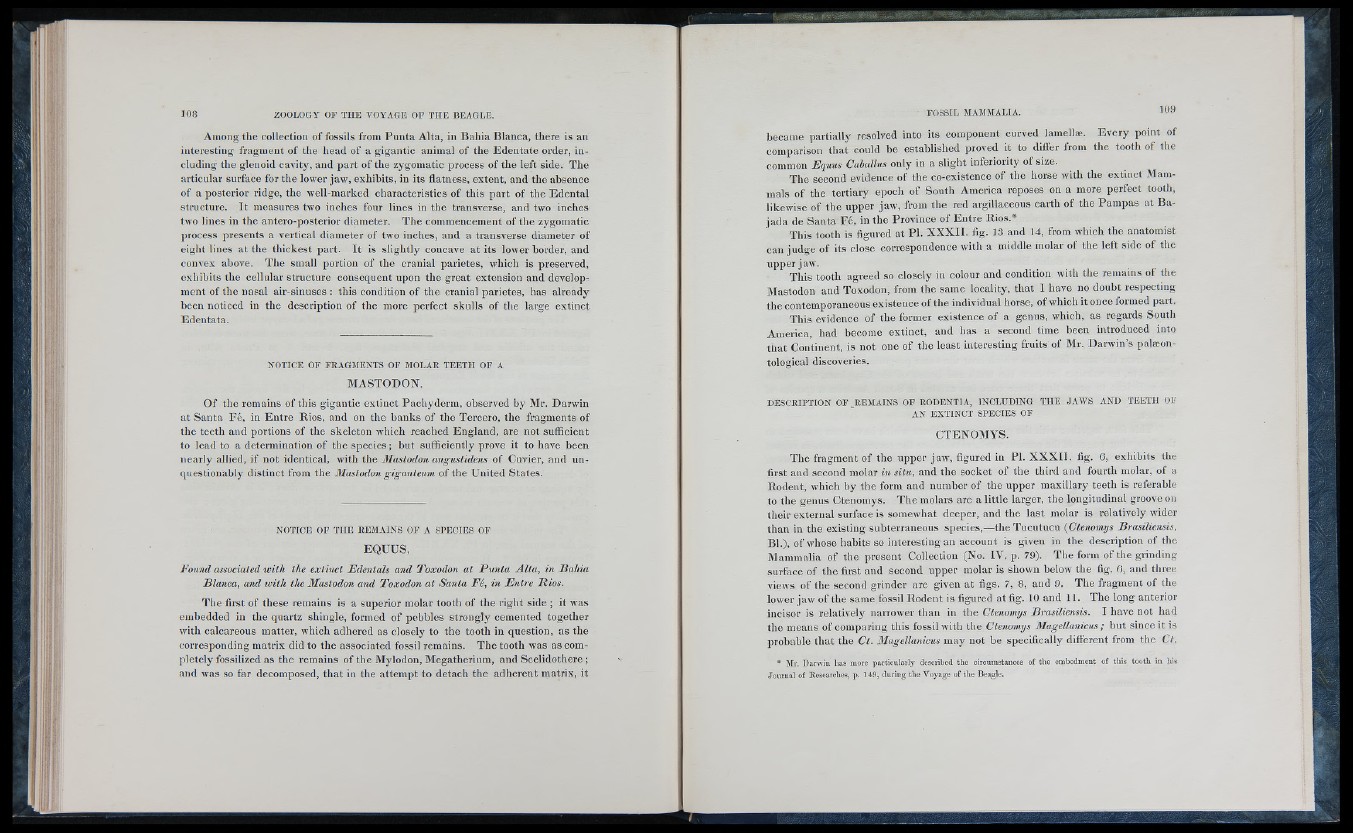
Among the collection o f fossils from Punta Alta, in Bahia Blanca, there is an
interesting fragment o f the head o f a gigantic animal o f the Edentate order, in cluding
the glenoid cavity, and part o f the zygomatic process o f the left side. The
articular surface for the lower jaw, exhibits, in its flatness, extent, and the absence
o f a posterior ridge, the well-marked characteristics of this part o f the Edental
structure. It measures two inches four lines in the transverse, and two inches
two lines ill the antero-posterior diameter. The commencement o f the zygomatic
process presents a vertical diameter o f two inches, and a transverse diameter o f
eight lines at the thickest part. It is sligh tly concave at its lower border, and
convex above. The small portion o f the cranial parietes, which is preserved,
exhibits the cellular structure consequent upon the great extension and development
o f the nasal air-sinuses : tliis condition o f the cranial parietes, has already
been noticed in the description o f the more perfect skulls o f the large extinct
Edentata.
NOTICE OF FRAGMENTS OF MOLAR TEETH OF A
MA STODON .
O f the remains o f this gigantic extinct Pachyderm, observed by Mr. Darwin
at Santa Fe, in Entre Rios, and on the banks o f the Tercero, the fragments o f
the teeth and portions o f the skeleton which reached England, are not sufficient
to lead to a determination o f the sp e c ie s; but sufficiently prove it to have been
nearly allied, i f not identical, with the Mastodon angustidexis o f Cuvier, and unquestionably
distinct from the Mastodon giganteum o f the United States.
NOTICE OF THE REMAINS OF A SRECIES OF
EQ U U S ,
Found associated w ith the extinct Edentals and Toxodon a t P u n ta A lta , in Bahia
Blanca, and w ith the Mastodon and Toxodon a t Santa Fe, in En tre R io s.
The first of these remains is a superior molar tooth o f the right side ; it was
embedded in the quartz shingle, formed o f pebbles strongly cemented together
ivith calcareous matter, which adhered as closely to the tooth in question, as the
corresponding matrix did to the associated fossil remains. The tooth was as complete
ly fossilized as the remains o f the Mylodon, Megatherium, and S c e lid o th e r e ;
and was so far decomposed, that in the attempt to detach the adherent matrix, it
FOSSIL MAMMALIA.
became partially resolved into its component curved lamellae. Ev ery point o f
comparison that could be established proved it to differ from the tooth o f the
common Equus Caballus only in a slight inferiority o f size.
The second evidence o f the co-existence o f tlie horse with the extinct Mammals
o f the tertiary epoch o f South America reposes on a more perfect tootli,
likewise o f the upper jaw, from the red argillaceous eautli o f the Pampas at Ba-
jada de Santa Fb, in the Province o f Entre Rios.*
Tiiis tooth is figured at P i. X X X I I . fig. 13 and 14, from which the anatomist
can judge o f its close correspondence witli a middle molar o f the le ft side o f the
upper jaw.
Th is tootli agreed so clo se ly in colour and condition with the remains o f the
Mastodon and Toxodon, from the same locality, that 1 have no doubt respecting
the contemporaneous ex istenc e o f the individual horse, o f which it once formed part.
This evidence o f the former existenc e of a genus, which, as regards Soutli
America, had become extinc t, and has a second time been introduced into
that Continent, is not one o f the least interesting fruits o f Mr. Darwin’s p a le o n tological
discoveries.
DESCRIPTION OP ^REMAINS OF RODENTIA, INCLUDING T IIE JAW S AND TEETH OF
AN EXTINCT SPECIES OF
CTENOMYS.
The fragment o f the upper jaw, figured in P i. X X X I I . fig. 6 , exh ib its the
first and second molar ¿/i situ, and the socket o f the third and fourth molar, o f a
Rodent, which b y the form and number o f the upper maxillary teeth is referable
to the genus Ctenomys. T he molars are a little larger, the longitudinal groove on
tlieir external surface is somewhat deeper, and tlie la st molar is relatively wider
than in the existing subterraneous sp e c ie s,—the Tucutucu {Ctenomys Brasiliensis,
Bl.), o f whose habits so interesting an account is given in the description o f the
Mammalia o f the present Collection (No. IV. p. 79). The form o f the grinding
surface o f the first and second upper molar is shown below the fig. 0 , and tliree
views o f tlie second grinder are given at figs. 7, 8 , and 9. The fragment o f the
lower jaw o f the same fossil Rodent is figured at fig. 10 and 1 1. The long anterior
incisor is relatively narrower than in the Ctenomys Brasiliensis. I have not liad
the means of comparing this fossil with the Ctenomys 3Iagellanicus ; but since it is
probable that the Ct. Slagellanicus may not be specifically different from the Ct.
* Sir. Darwin has more particularly described the circumstances of the embedment of this tooth in his
Journal of Researches, p. 149, during the Voyage of the I